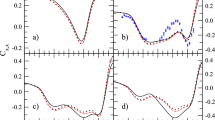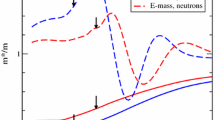Abstract
We present expressions for the matrix elements of the spin–spin operator \(\mathbf {S}_\mathrm{n}\cdot \mathbf {S}_\mathrm{p}\) in a variety of coupling schemes. These results are then applied to calculate the expectation value \(\langle \mathbf {S}_\mathrm{n}\cdot \mathbf {S}_\mathrm{p}\rangle \) in eigenstates of a schematic Hamiltonian describing neutrons and protons interacting in a single-l shell through a Surface Delta Interaction. The model allows us to trace \(\langle \mathbf {S}_\mathrm{n}\cdot \mathbf {S}_\mathrm{p}\rangle \) as a function of the competition between the isovector and isoscalar interaction strengths and the spin–orbit splitting of the \(j=l\pm {{1}\big /{2}}\) shells. We find negative \(\langle \mathbf {S}_\mathrm{n}\cdot \mathbf {S}_\mathrm{p}\rangle \) values in the ground state of all even–even \(N=Z\) nuclei, contrary to what has been observed in hadronic inelastic scattering at medium energies. We discuss the possible origin of this discrepancy and indicate directions for future theoretical and experimental studies related to neutron–proton spin–spin correlations.







Similar content being viewed by others
Data Availability Statement
This manuscript has no associated data or the data will not be deposited. [Authors’ comment: The paper contains no additional data. All results, in particular those shown in the figures, can be deduced from the equations given in the paper.]
References
A. Bohr, B.R. Mottelson, D. Pines, Phys. Rev. 110, 936 (1958)
R.A. Broglia, V. Zelevinsky (eds.), Fifty Years of Nuclear BCS (World Scientific, Singapore, 2013)
D.M. Brink, R.A. Broglia, Nuclear Superfluidity: Pairing in Finite Systems (Cambridge University Press, Cambridge, 2005)
S. Frauendorf, A.O. Macchiavelli, Prog. Part. Nucl. Phys. 78, 24 (2014). and references therein
A.O. Macchiavelli, Fifty Years of Nuclear BCS (World Scientific, Singapore, 2013), p. 432
A.V. Afanasjev, Fifty Years of Nuclear BCS (World Scientific, Singapore, 2013), p. 138
R.A. Broglia, O. Hansen, C. Riedel, Two-Neutron Transfer Reactions and the Pairing Model, in Advances in Nuclear Physics, ed. by M. Baranger, E. Vogt (Springer, Boston, 1973)
B.F. Bayman, N.M. Hintz, Phys. Rev. 172, 1113 (1968)
J. Engel, K. Langanke, P. Vogel, Phys. Lett. B 389, 211 (1996)
P. Fröbrich, Phys. Lett. B 37, 338 (1971)
P. Van Isacker, D.D. Warner, A. Frank, Phys. Rev. Lett. 94, 162502 (2005)
H. Matsubara, PhD Dissertation (Osaka University, Department of Physics, 2010)
H. Matsubara et al., Phys. Rev. Lett. 115, 102501 (2015)
A. Tamii, Invited Talk (University of Hong Kong, Workshop on Np Correlations, July 2015)
H. Sagawa, T. Suzuki, Phys. Rev. C 97, 054333 (2018)
B.R. Barrett, P. Navratil, J.P. Vary, Prog. Part. Nucl. Phys. 69, 131 (2013)
B. Cederwall, F. Moradi, T. Bäck et al., Nature (Lond.) 469, 68 (2011)
R. Subedi, R. Shneor, P. Monaghan et al., Science 320, 1476 (2008)
E. Wigner, Phys. Rev. 51, 106 (1937)
A. de-Shalit, I. Talmi, Nuclear Shell Theory (Academic Press, New York, 1963)
I. Talmi, Simple Models of Complex Nuclei. The Shell Model and the Interacting Boson Model (Harwood, Chur, 1993)
P.J. Brussaard, P.W.M. Glaudemans, Shell-Model Applications in Nuclear Spectroscopy (North-Holland, Amsterdam, 1977)
A. Bohr, B.R. Mottelson, Nuclear Structure I, Single-Particle Motion (Benjamin, New York, 1969)
A.F. Lisetskiy, R.V. Jolos, N. Pietralla, P. von Brentano, Phys. Rev. C 60, 064310 (1999)
A. O. Macchiavelli et al., iThemba Proposal PR353 (2019)
M. Hamermesh, Group Theory and Its Application to Physical Problems (Addison-Wesley, Reading, 1962)
J.P. Elliott, J.A. Evans, Phys. Lett. B 101, 216 (1981)
Acknowledgements
This work is based on research supported in part by the Director, Office of Science, Office of Nuclear Physics, of the U.S. Department of Energy under Contract No. DE-AC02-05CH11231 (LBNL).
Author information
Authors and Affiliations
Corresponding author
Additional information
Communicated by Mark Caprio
Appendix: SU(4) character of \(\mathbf {S}_\mathrm{n}\cdot \mathbf {S}_\mathrm{p}\)
Appendix: SU(4) character of \(\mathbf {S}_\mathrm{n}\cdot \mathbf {S}_\mathrm{p}\)
The tensor character of \(\mathbf {S}_\mathrm{n}\cdot \mathbf {S}_\mathrm{p}\) under SU(4) can be determined by noting that the generators (3) transform as \([211]\equiv (101)\) tensors, where the first refers to the notation \([f'_1f'_2f'_3]\equiv [f_1-f_4,f_2-f_4,f_3-f_4]\) in terms of the Young tableau \([f_1f_2f_3f_4]\) (for a discussion of the latter, see Ref. [29]) and the second is the notation of supermultiplets from Ref. [30], \((\lambda \mu \nu )\equiv (f_1-f_2,f_2-f_3,f_3-f_4)\). The tensor character of any product of the SU(4) generators must therefore belong to
Furthermore, since \(\mathbf {S}_\mathrm{n}\cdot \mathbf {S}_\mathrm{p}\) is a scalar in spin and a combination of a scalar and a tensor in isospin, it can only belong to an SU(4) irreducible representation which contains the spin–isospin combinations \((ST)=(00)\) or (02). Given the \(\mathrm{SU}(4)\supset \mathrm{SU}_S(2)\otimes \mathrm{SU}_T(2)\) reductions
it follows that \(\mathbf {S}_\mathrm{n}\cdot \mathbf {S}_\mathrm{p}\) must be a combination of (000), (020) and (202) SU(4) tensors.
Rights and permissions
About this article
Cite this article
Van Isacker, P., Macchiavelli, A.O. Neutron–proton spin–spin correlations in the ground states of \(N=Z\) nuclei. Eur. Phys. J. A 57, 178 (2021). https://doi.org/10.1140/epja/s10050-021-00489-6
Received:
Accepted:
Published:
DOI: https://doi.org/10.1140/epja/s10050-021-00489-6




